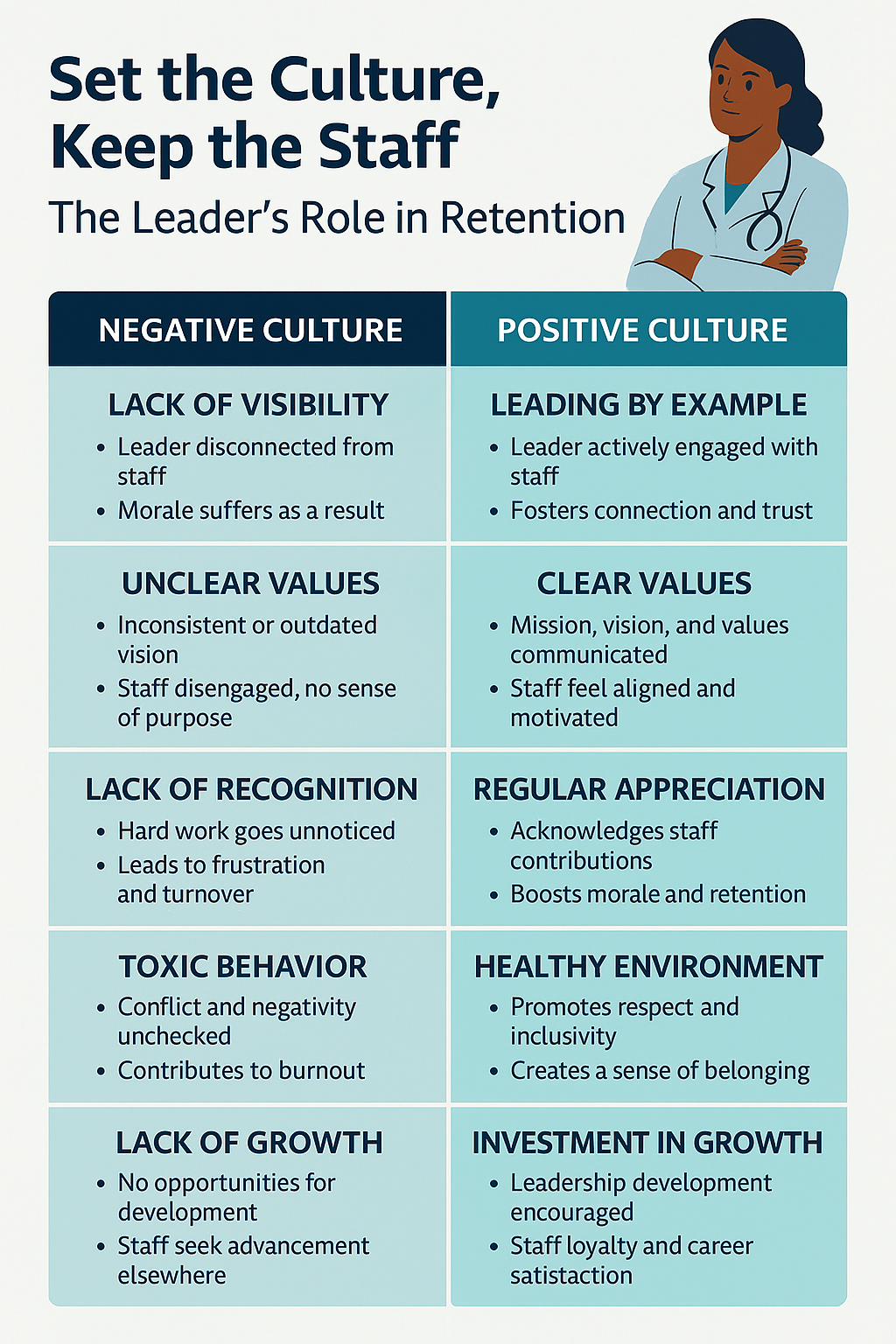By the time most leaders start asking why their staff are leaving, it’s already too late.
They look at the turnover numbers. Exit interviews. Backchannel whispers. Then they try to correct course with what they assume are the real levers: better pay, more flexible schedules, maybe a one-time bonus. Sometimes it helps. But more often, the damage has been done- because the real reasons people leave were never in the HR policy. They were in the culture.
And culture? Culture is not a mystery. It’s not your mission statement, your DEI page, or what the company says about itself on social media. It’s what happens in meetings, in 1:1s, in decision-making, and in moments of conflict. It’s how safe someone feels to speak up, how fairly they’re treated, how clearly priorities are defined, and how consistently leaders act on what they say matters.
More than anything, culture is shaped, and sometimes broken, by the day-to-day behavior of leadership.
That’s not a platitude. That’s a measurable, research-backed reality. And for teams trying to reduce attrition, boost morale, and retain their top performers, it’s time to treat culture not as a vibe but as a lever. One that can be pulled, or neglected, every single day.

Join our Leadership Group working towards reshaping healthcare culture. Enjoy Newsletters, Group Discussion, and One-on-One Mentorship.
The Myth of Culture as an “HR Problem”
One of the biggest misconceptions in organizations today is that culture is a department.
There’s an assumption that HR, People Ops, or some newly formed Culture Committee is responsible for creating and maintaining the “vibe” of a workplace. Leaders often see themselves as either consumers of that culture or protectors of it. But not its creators.
That’s backwards.
Culture doesn’t live in the onboarding packet. It lives in the leadership behaviors people see and experience. When managers communicate expectations inconsistently, reward burnout over sustainability, or shut down disagreement, they are writing a silent rulebook that spreads faster than any policy manual ever could.
The inverse is also true. When leaders make decisions transparently, admit their own missteps, listen without punishment, and recognize contributions equitably, they send a different message: “This is a place where people matter- and how we treat each other matters, too.”
Whether a team thrives or starts updating their resumes often comes down to which of those two environments leadership has built.
The Retention Crisis Isn’t Just About Pay
Let’s address the elephant in the room. Yes, compensation matters. No one’s staying in a toxic environment just for bean bag chairs and pizza Fridays. But the data is clear: toxic culture is more than 10 times more predictive of attrition than compensation. [Sull et al., 2022]
Read that again.
In the middle of what’s been called the Great Resignation, researchers from MIT Sloan found that while many companies rushed to offer bonuses or higher base pay to keep staff, it was culture, particularly toxic culture, that most accurately predicted whether people stayed or left. Things like disrespect, exclusion, favoritism, lack of recognition, or leadership hypocrisy weren’t just unpleasant. They were fatal to retention.
In fact, many of the top reasons employees cite for leaving include:
- Not feeling respected or heard
- Lack of transparency in decisions
- Inconsistent expectations
- Lack of growth opportunities
- Unsustainable workloads
These aren’t problems HR can fix from the outside. These are symptoms of leadership behavior.
How does your salary and compensation package compare? Get our 2025 Nurse Leader Salary Guide to see!

Leadership Behaviors That Shape Culture
Ask most people what their manager is like, and you’ll hear a mix of personality traits and habits. “They’re super driven, but kind of reactive.” “Really supportive, but not great with clarity.” “They’re great one-on-one, but in meetings they dominate everything.”
That’s culture in action.
What most people call “culture” is really a pattern of leadership habits that either create safety, clarity, and growth, or instability, silence, and stress.
And while no leader is perfect, the difference between a culture that retains versus one that repels is whether those behaviors are consistent, fair, and intentional.
Let’s break down a few of the most important ones.
Psychological Safety
Amy Edmondson, a Harvard professor and pioneer in the field of team dynamics, defined psychological safety as a shared belief that a team is safe for interpersonal risk-taking. That includes speaking up, admitting mistakes, and challenging decisions without fear of punishment or humiliation.
In her studies, teams with high psychological safety not only made fewer critical errors- they learned faster and performed better. Why? Because they weren’t hiding problems. They were surfacing them early and learning from them. [Edmondson, 1999]
When leaders react to bad news with blame, dismiss feedback, or get defensive when challenged, they destroy that safety. And once it’s gone, employees check out. Innovation slows. Feedback dries up. People start looking for somewhere safer to care.
Clarity of Expectations
Clarity isn’t sexy, but it’s powerful. When people know what’s expected of them- what good looks like, what’s a priority, and how success is measured- they’re more confident and less anxious.
Yet Gallup data consistently shows that one of the top engagement killers is ambiguity. In its latest 2024 report, Gallup found that only 50% of U.S. workers clearly understand what’s expected of them. [Gallup, 2025]
That uncertainty fuels misalignment, rework, burnout, and frustration, especially when priorities change midstream without explanation.
Leaders who proactively define what’s most important, explain trade-offs, and follow through on what they say build trust. They don’t just avoid churn, they unlock performance.
Recognition and Fairness
When employees feel like their work is invisible, or that rewards and recognition go only to the loudest or most favored, resentment builds.
On the other hand, when leaders offer regular, specific, and sincere recognition- and apply consistent standards for advancement or opportunities- people feel seen and motivated.
Fairness isn’t about everyone getting the same. It’s about everyone knowing the rules are consistent and based on merit.
And recognition isn’t optional. According to Workhuman and Gallup, employees who feel adequately recognized are five times more likely to stay with their company. [Workhuman & Gallup, 2023]
Growth and Autonomy
Most high-performing employees don’t leave just because they’re unhappy, they leave because they stop growing.
When leaders hoard responsibility, micromanage, or avoid delegating stretch opportunities, they signal that development isn’t a priority.
By contrast, great leaders actively look for ways to challenge people with support, giving them space to learn while offering air cover if things go sideways.
This is especially important for millennials and Gen Z- generations that tend to value development over perks, and career growth over quick praise.

Curious what a top-down, culture-first search could do for your unit? Schedule a no-commitment, free call today!
Culture Isn’t What You Say- It’s What You Tolerate
One of the biggest traps leaders fall into is believing that culture is defined by what they encourage. In reality, it’s more often defined by what they allow.
If disrespect goes unchecked, it spreads. If burnout is rewarded, it becomes the norm. If favoritism determines who gets opportunities, others stop trying.
What you tolerate becomes your culture.
This is especially true in team settings where silence is easy. No one wants to rock the boat. But without active reinforcement of values, the loudest or most self-serving behaviors take over.
The most effective leaders don’t just model good culture, they maintain it. They call out poor behavior. They protect people’s time and energy. They ensure that values aren’t just banners but daily decisions.
Culture is Built in Moments, Not Memos
So if culture is leadership in motion, what does it look like on the ground?
It’s the meeting where a junior team member raises a concern and the leader responds with “That’s a good catch. Let’s dig into it,” instead of shutting them down.
It’s the 1:1 where someone admits they’re overwhelmed and the manager helps them reprioritize instead of praising their ability to “push through.”
It’s the promotion cycle where criteria are published in advance, applied consistently, and followed up with feedback, not mystery and disappointment.
These aren’t dramatic actions. They’re habits. Small decisions made consistently that accumulate into trust – or attrition.
The Cost of Culture Neglect
According to SHRM, the cost of replacing an employee can range from 30% to 200% of their annual salary depending on their role and experience. [SHRM, 2019]
For leadership and high-skill positions, that number climbs fast. Factoring in recruitment costs, onboarding time, productivity loss, and institutional knowledge walking out the door.
But the bigger cost is invisible: the erosion of morale among those who stay behind.
When teams see talented, values-aligned people leave because of leadership issues that go unaddressed, the signal is loud and clear: “This place doesn’t listen. It doesn’t change. And maybe it’s not worth staying for.”
That’s when disengagement sets in. Innovation slows. Silos form. And even the most promising teams plateau.
Join our Leadership Group working towards reshaping healthcare culture. Enjoy Newsletters, Group Discussion, and One-on-One Mentorship.
What Modern Teams Want From Their Leaders
In the wake of COVID, remote work shifts, and generational turnover, expectations around leadership have changed. Millennials (now the largest generation in the workforce) and Gen Z aren’t looking for ping-pong tables or nap pods.
They want leaders who:
- Tell the truth, even when it’s hard
- Give feedback and receive it without ego
- Delegate authority, not just tasks
- Create space for disagreement
- Reward progress, not just perfection
- Make growth a shared responsibility
- Protect people’s well-being, not exploit it
These aren’t soft skills. They’re retention levers.
And companies that want to keep their talent- especially their rising leaders- need to treat culture like infrastructure, not decor.
So What Now? A Leadership Reflection
If you’re a manager or executive reading this, here’s the invitation:
Start by asking yourself: “What are the silent rules I’ve created on my team?” Not what you hope people believe, but what your behaviors have taught them.
Do they feel safe bringing up concerns?
Do they know what matters most this week?
Do they trust that promotions and recognition are based on contribution, not proximity?
Do they have room to grow without burning out?
These are hard questions. But they’re the right ones. Because the answers will tell you where culture is thriving, and where it needs your attention.
Culture isn’t an initiative. It’s a habit. One only leaders can set.
And in a world where talent has more choice than ever, leadership that prioritizes clarity, fairness, and care is no longer optional- it is the only sustainable path forward.
Sources
- Edmondson, A. (1999). Psychological Safety and Learning Behavior in Work Teams. Administrative Science Quarterly.
- Gallup (2025). U.S. Employee Engagement Sinks to 10-Year Low.
- Sull, D., Sull, C., & Zweig, B. (2022). Toxic Culture Is Driving the Great Resignation. MIT Sloan Management Review.
- SHRM (2019). The Real Cost of Employee Turnover.
- Workhuman & Gallup (2023). Empowering Workplace Recognition.
- McKinsey & Company (2022). Great Attrition or Great Attraction? The Choice is Yours.

